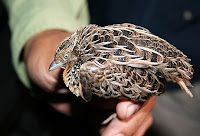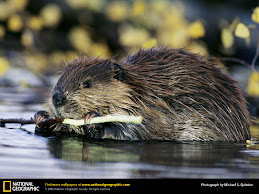skip to main |
skip to sidebar
 These are scary times: the stock market tanking, banks collapsing, jobs vanishing, state and city budgets imploding, the housing bubble burst.
These are scary times: the stock market tanking, banks collapsing, jobs vanishing, state and city budgets imploding, the housing bubble burst.
As Bill Clinton’s team reminded him frequently in 1992, “it’s the economy, stupid.”
But wait. If you place your finger on the pulse of the planet, you’ll discover that temperatures are rising, glaciers melting, oceans warming, sea levels rising, rainforests burning, coral reefs dying, old-growth forests disappearing, deserts spreading, the world’s population rising, and species vanishing at record rates.
It’s also the ecology, stupid.
Yesterday, Vice President Joe Biden inaugurated his Middle Class Task Force in Philadelphia, presenting a panel discussion on the emerging green economy. Green collar jobs, everyone noted, is a key path out of our economic wilderness.
As an educator plowing the environmental field for 30 years, this is a hallelujah moment, as at long last there seems to be some recognition that the ecology underpins our economy, that the health of the two have been long connected, and that we have a unique opportunity to restore both, to, as it were feed two birds with the same crumb.
Finally, there is a unique confluence of economy AND ecology, and we no longer have to choose between them.
I hope this moment lasts.
 An extraordinary book crossed my desk the other day, arriving at a critically important moment. The Last Polar Bear from Braided River Books is described as a “photographic journey” by photographer Steven Kazlowski. It’s a coffee table book overflowing with photos of polar bears (not to mention seals, whales, walruses, Eskimos, and more), sharing the bear’s incredible natural history while cementing its place in the annals of environmental concern. Like eagles and peregrines were the 1960s symbol of DDT’s impact, the polar bear has become a reluctant poster child for global warming.
An extraordinary book crossed my desk the other day, arriving at a critically important moment. The Last Polar Bear from Braided River Books is described as a “photographic journey” by photographer Steven Kazlowski. It’s a coffee table book overflowing with photos of polar bears (not to mention seals, whales, walruses, Eskimos, and more), sharing the bear’s incredible natural history while cementing its place in the annals of environmental concern. Like eagles and peregrines were the 1960s symbol of DDT’s impact, the polar bear has become a reluctant poster child for global warming.
But the terrain the book covers is expansive, as Bear includes a series of elegiac essays from notable writers like Theodore Roosevelt IV, Newsweek correspondent Dan Glick, and several Alaskan environmental writers. These essays dive into politics, climate change, natural history, Inupiat Eskimo culture, and a whole lot more.
The book opens with a preface by Helen Cherullo, executive director of Braided River Books, the nonprofit publishing house that released Bear, who took Kazlowski to Congress in 2007 to share his photos. His presentation ended with a photo of a polar bear in a zoo, with him noting that “within decades, this could be the only place on earth a polar bear will be found.”So the book’s title is a preemptive shot across the bow of American culture. But remember, the Interior Department finally bowed to pressure (and court orders) and listed the bears as a threatened species, threatened because the ice upon which they depend is thawing underneath them—far faster than scientists imagined possible. A study by the U.S. Geological Survey, released last fall, predicts that two-thirds of the world’s polar bears, including Alaska’s entire population, may disappear completely by 2050.The last two years saw record ice melt in Arctic Ocean summers, and many scientists are now predicting ice-free summers in coming decades. Polar bears, of course, use this ice to move about, find mates and hunt for seals. As temperatures warm, the loss of the pack ice directly impacts their ability to survive. Right now, as the long Arctic winter winds down, mother polar bears are nursing their young in ice-bound dens while hibernating. In March or April, the mother and pups emerge from their dens to start the new spring season.
What kind of world will the polar bears emerge into this year? That’s partly up to you. Grab this book. The Last Polar Bear: Facing the Truth of a Warming World. Braided River Books, February 28, 2008 235 color photos, 192 pages, 10”x12”, Hardcover. Photos courtesy of Braided River Books and Steven Kazlowski.
 This is amazingly sad. A Worcester's buttontail quail, a shy Philippine bird long thought to be extinct by scientists, was FOUND recently in the wild…
This is amazingly sad. A Worcester's buttontail quail, a shy Philippine bird long thought to be extinct by scientists, was FOUND recently in the wild…
..but promptly eaten. After it was photographed, the bird was sold in a local marketplace as food. Sigh.
 So Obama flew to Denver today to sign the much-discussed $787 billion stimulus package—thank you, Senator Specter—and while we’ll hold our breath waiting to see if it works, as a card-carrying environmental guy, it was hard not to smile, bad as the economy is. Renewable energy was a bright spot in the bill. He signed the bill at the Denver Museum of Nature and Science, first visiting the solar panels on its roof with the youthful head of Namaste Solar Electric, a small Colorado company that installed similar panels on the governor’s mansion there. Obama saw the future, and it worked. The stimulus bill “is an investment that will double the amount of renewable energy produced over the next three years,” Obama noted, promising it will “transform the way we use energy.” Included in the package are $5 billion for low-income weatherization programs, several billion to modernize federal buildings for energy efficiency, $11 billion for “smart grid” investments, $3.4 billion for clean coal, $2 billion for research electric car batteries, $500 million in green job training, a three-year extension of the “production tax credit” for renewable energy projects like biomass, geothermal, landfill gas and some hydropower projects, and tons of energy-saving mass transit projects across the country. Two quick thoughts: First, Obama could easily right a longstanding wrong by putting solar collectors back atop the White House. Installed on the West Wing (photo, below right) by the cardigan-carrying Jimmy Carter in the 1970s, Ronald Reagan’s very first act as president was to
So Obama flew to Denver today to sign the much-discussed $787 billion stimulus package—thank you, Senator Specter—and while we’ll hold our breath waiting to see if it works, as a card-carrying environmental guy, it was hard not to smile, bad as the economy is. Renewable energy was a bright spot in the bill. He signed the bill at the Denver Museum of Nature and Science, first visiting the solar panels on its roof with the youthful head of Namaste Solar Electric, a small Colorado company that installed similar panels on the governor’s mansion there. Obama saw the future, and it worked. The stimulus bill “is an investment that will double the amount of renewable energy produced over the next three years,” Obama noted, promising it will “transform the way we use energy.” Included in the package are $5 billion for low-income weatherization programs, several billion to modernize federal buildings for energy efficiency, $11 billion for “smart grid” investments, $3.4 billion for clean coal, $2 billion for research electric car batteries, $500 million in green job training, a three-year extension of the “production tax credit” for renewable energy projects like biomass, geothermal, landfill gas and some hydropower projects, and tons of energy-saving mass transit projects across the country. Two quick thoughts: First, Obama could easily right a longstanding wrong by putting solar collectors back atop the White House. Installed on the West Wing (photo, below right) by the cardigan-carrying Jimmy Carter in the 1970s, Ronald Reagan’s very first act as president was to remove those offensive symbols of our energy ennui from the rooftop. Putting them back would be an easy symbolic gesture. Second, Obama’s done a lot right on the environment. But his one error is a whopper: clean coal is a classic oxymoron. It doesn’t work and is not shovel-ready. While King Coal is undoubtedly crowing, we desperately need to shift energy policy in a different direction, and we’ll pour money down a bottomless clean-coal mine shaft and one day realize it didn’t go very far. You watch. We’ll continue following that story and report as developments occur. Until then, there is plenty of good green news in the stimulus bill.
remove those offensive symbols of our energy ennui from the rooftop. Putting them back would be an easy symbolic gesture. Second, Obama’s done a lot right on the environment. But his one error is a whopper: clean coal is a classic oxymoron. It doesn’t work and is not shovel-ready. While King Coal is undoubtedly crowing, we desperately need to shift energy policy in a different direction, and we’ll pour money down a bottomless clean-coal mine shaft and one day realize it didn’t go very far. You watch. We’ll continue following that story and report as developments occur. Until then, there is plenty of good green news in the stimulus bill.
 These are scary times: the stock market tanking, banks collapsing, jobs vanishing, state and city budgets imploding, the housing bubble burst.
These are scary times: the stock market tanking, banks collapsing, jobs vanishing, state and city budgets imploding, the housing bubble burst.





